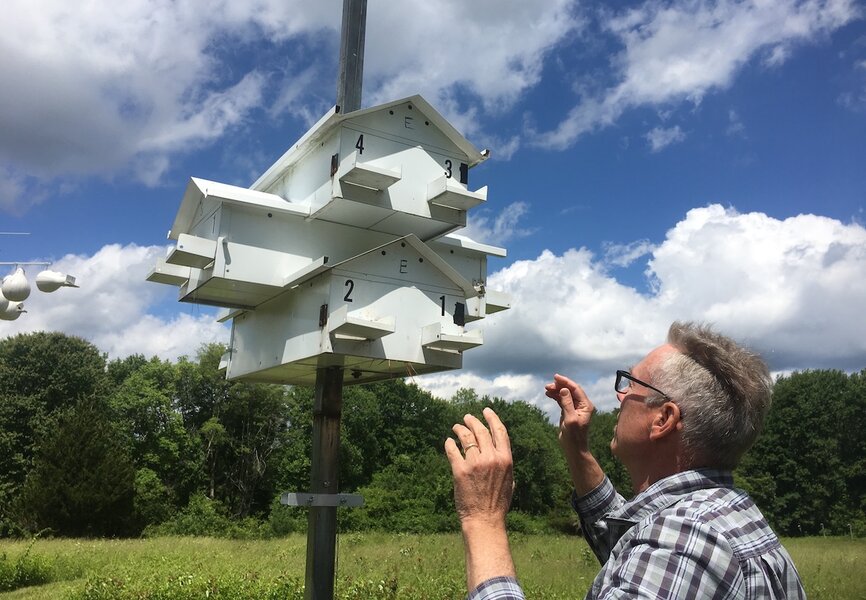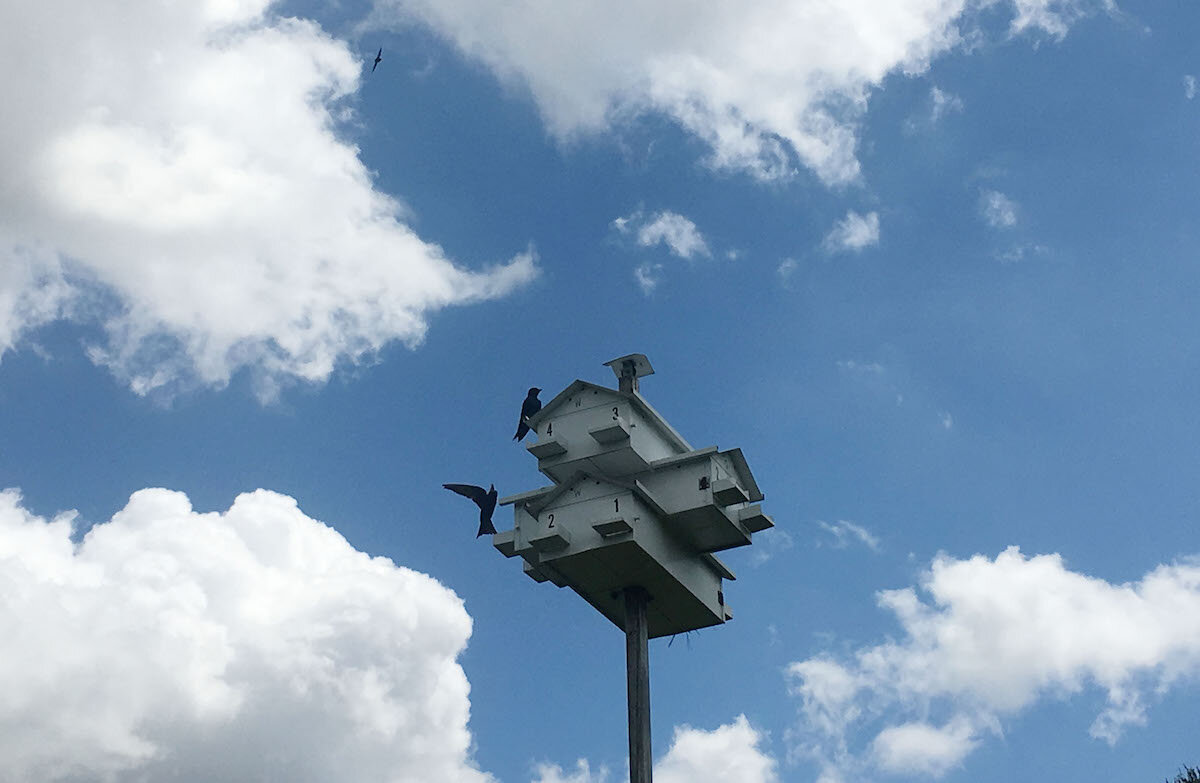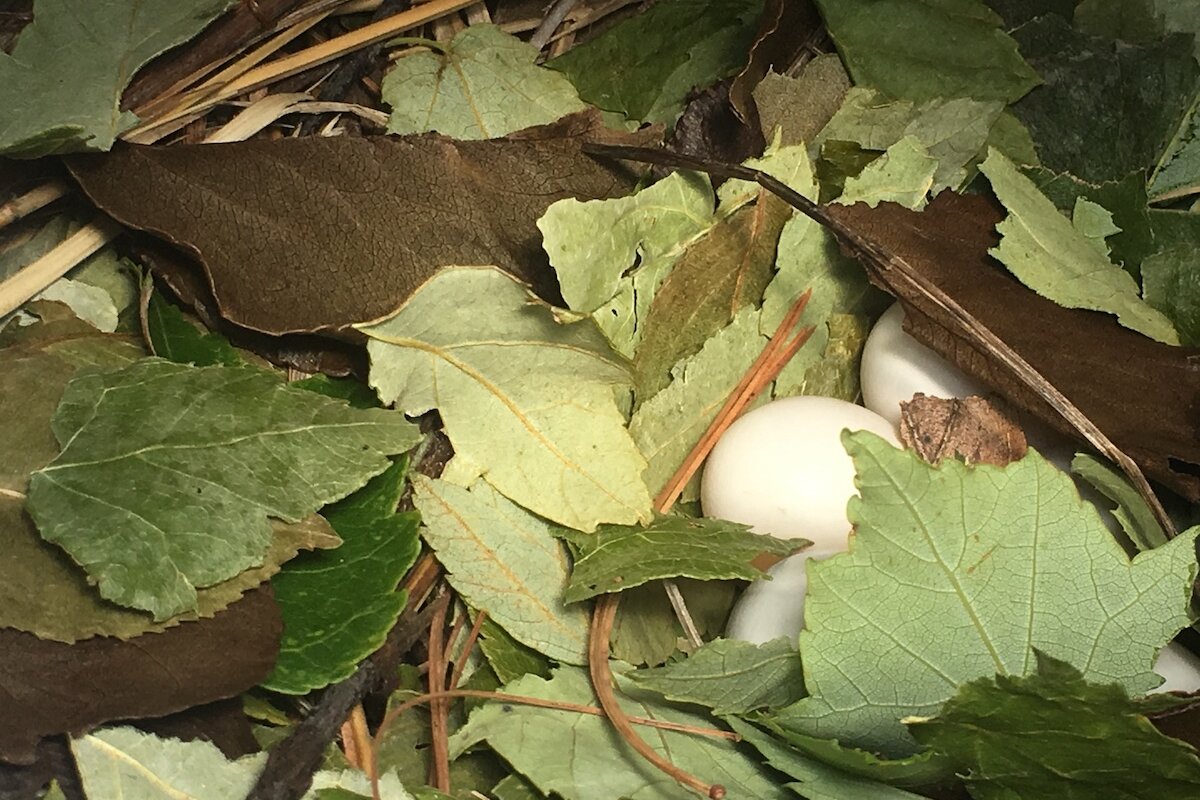Human landlords, avian tenants: How purple martins survive
Loading...
| Norfolk, Mass.
Each spring, thousands of purple martins fly from the Amazon rainforest to North America for their nesting season. But in the eastern half of the United States, instead of settling in tree branches or bushes, nearly all are welcomed into houses built by human landlords when they arrive.
“These birds have a history of interacting with humans, going all the way back to Native Americans before European settlement,” says purple martin conservationist Joe Siegrist.
Why We Wrote This
Sometimes living in harmony with nature means offering a little help. A long-standing effort to house and nurture purple martins is showing success.
Today, many thousands of purple martin landlords still provide nesting cavities and guard against predators and invasive species. They support a relatively stable population of birds in the eastern half of the U.S., with some local fluctuations.
Citizen science initiatives have been key to the success of purple martin conservation, Mr. Siegrist says. As people become more in tune to the wildlife in their backyards, they develop a sense of ecological literacy.
“For now, the populations do seem pretty stable,” says Robyn Bailey, the project leader of a citizen science initiative called NestWatch. “Assuming that people continue to provide managed housing, that paints a fairly optimistic picture.”
In the middle of a nondescript field of grass at the Massachusetts Audubon Society’s Stony Brook Wildlife Sanctuary, three large birdhouses balance improbably atop 12-foot metal poles. There’s no sign of the occupants, though, until a dark fleck appears from nowhere, swooping through the air and chirruping a sharp, sweet song. Suddenly, one becomes three becomes a dozen – until a small cloud of birds is circulating around the poles in an electric display of aerial maneuvering and operatic warbling.
The birds are purple martins, a large species of swallow with dark iridescent feathers and a diet of flying insects. Each spring, thousands fly from the Amazon rainforest to North America for their nesting season. But in the eastern half of the United States, instead of settling in tree branches or bushes, nearly all are welcomed into houses built by human landlords when they arrive.
“These birds have a history of interacting with humans, going all the way back to Native Americans before European settlement,” says Joe Siegrist, president and chief executive of the Purple Martin Conservation Association (PMCA). Native Americans reportedly “used to hang hollowed-out gourds in their villages, and the purple martins latched on.” Humans liked the birds for their fascinating behavior, and also their diet of pesky bugs. That connection, Mr. Siegrist says, allowed purple martins to survive the incursion of European settlers, who destroyed forests with natural purple martin nesting sites like old woodpecker holes.
Why We Wrote This
Sometimes living in harmony with nature means offering a little help. A long-standing effort to house and nurture purple martins is showing success.
Settlers also introduced invasive species such as the European starling and English house sparrow, which out-competed purple martins for natural nesting sites. But by the 1830s, the practice of purple martin landlording had been so widely adopted by settlers that famed ornithologist and painter John James Audubon noted “Almost every country tavern has a martin box on the upper part of its sign-board; and I have observed that the handsomer the box, the better does the inn generally prove to be.”
Today, many thousands of purple martin landlords still provide nesting cavities and guard against predators and invasive species. They support a relatively stable population of birds in the eastern half of the U.S., with some local fluctuations. For example, populations appear to be declining in Louisiana and parts of the Gulf Coast, but increasing in southern parts of Texas, says Robyn Bailey, the project leader of a citizen science initiative called NestWatch from The Cornell Lab of Ornithology in Ithaca, New York. According to Mr. Siegrist, invasive species or pesticides may influence population sizes. Data from NestWatch, however, show that purple martins led the top 10 list in nesting success in both 2016 and 2018.
“For now, the populations do seem pretty stable,” says Ms. Bailey. “Assuming that people continue to provide managed housing, that paints a fairly optimistic picture.” That optimism, she adds, is because purple martins “are very charismatic and beautiful and people have a straightforward way to help them, which is fortunate – a lot of species don't have [that].”
In recent years, the true success of purple martin conservation is its citizen science initiatives. Such projects are designed to allow members of the public to meaningfully contribute to scientific research and experiments. “Citizen science projects ... help folks get more in tune with what's happening in their backyard,” says Mr. Siegrist. “[Participants] become ecologically literate and understand the linkage between their backyard and the natural world as a whole.”
eBird, for example, is the largest biodiversity-related citizen science project in the world, collecting data from hundreds of thousands of contributors and reporting more than 100 million bird sightings each year. And the PMCA is a leader among purple martin-specific data collection projects, with nearly 3,000 scout sightings reported in 2018.
Stony Brook Wildlife Sanctuary is one data contributor to those projects. Each week during nesting season, a sanctuary worker lowers the purple martin houses using a winch and looks inside to count eggs, check for signs of invasive species, and tally colony numbers.
That data can indicate bigger changes that aren’t immediately apparent, says Stony Brook Wildlife Sanctuary director Doug Williams. “People recognized a long time ago that some of the species that do these big migrations ... were arriving earlier and earlier every year, and [wondered] ‘What's going on with that?’ And that could be one of the early indicators of climate change.”
Purple martins’ dependence on human housing has some downsides. “The risk is if [purple martins] are going to be conservation-reliant,” says Ms. Bailey. She cites surveys and demographic studies which show that purple martin landlords are, on average, in their early sixties. Some conservation groups, including the PMCA, worry about the future of purple martin housing as current landlords age.
But, Ms. Bailey adds, “[Birding] is a topic that is increasing among young people. We know birding is every bit as popular nowadays as hunting and fishing.” The question then becomes “how to help . . . recruit [more] people.”
And purple martins continue to capture human attention. “Folks just tune into the activity, the swooping, the color, the song – it’s captivating,” says Mr. Siegrist. “You're kind of helping them survive where humans have failed in the past. ... It's an emotional link that folks end up having with the purple martins.”
And, he adds, “It's one of the easiest things that a person can do to ensure the survival of a species. … And it's not just that they're a beautiful bird, and fun to watch. They're an integral part of our ecosystem.”










